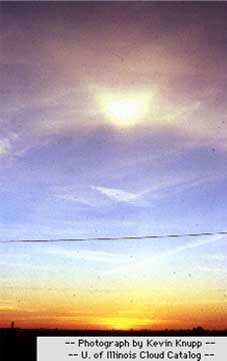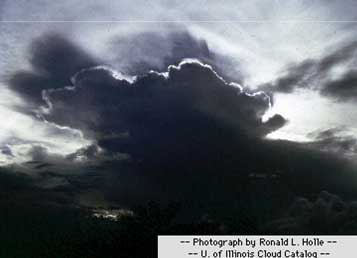Atmospheric pressure
is the pressure at any point in the Earth's
atmosphere. In most circumstances atmospheric pressure is closely approximated
by the hydrostatic pressure caused by the weight of air above the measurement
point. Low pressure areas have less atmospheric mass above their location,
whereas high pressure areas have more atmospheric mass above their location.
Similarly, as elevation increases there is less overlying atmospheric mass,
so that pressure decreases with increasing elevation. A column of air 1
square inch in cross section, measured from sea level to the top of the
atmosphere, would weigh approximately 14.7 lbf. A 1 m (11 sq ft)
column of air would weigh about 100 kilonewtons (equivalent to a mass of
10.2 tonnes at the surface).
------Atmospheric Pressure Wikipedia 2007
Cloud Types
Common Cloud Classifications
Clouds are classified into a system that uses
Latin words to describe the appearance of clouds as seen by an observer
on the ground. The table below summarizes the four principal components
of this classification system (Ahrens, 1994).
| Latin Root |
Translation |
Example |
cumulus
stratus
cirrus
nimbus |
heap
layer
curl of hair
rain |
fair weather cumulus
altostratus
cirrus
cumulonimbus |
Further classification identifies clouds by height
of cloud base. For example, cloud names containing the prefix "cirr-",
as in cirrus clouds, are located at high levels while cloud names with
the prefix "alto-", as in altostratus, are found at middle levels. This
module introduces several cloud groups. The first three groups are identified
based upon their height above the ground. The fourth group consists of
vertically developed clouds, while the final group consists of a collection
of miscellaneous cloud types.
 |
High-Level Clouds
High-level clouds form above 20,000 feet (6,000
meters) and since the temperatures are so cold at such high elevations,
these clouds are primarily composed of ice crystals. High-level clouds
are typically thin and white in appearance, but can appear in a magnificent
array of colors when the sun is low on the horizon.
|
 |
Photograph by: Holle
Mid-Level Clouds
The bases of mid-level clouds typically appear
between 6,500 to 20,000 feet (2,000 to 6,000 meters). Because of their
lower altitudes, they are composed primarily of water droplets, however,
they can also be composed of ice crystals when temperatures are cold enough.
|
 |
Low-level Clouds
Low clouds are of mostly composed of water droplets
since their bases generally lie below 6,500 feet (2,000 meters). However,
when temperatures are cold enough, these clouds may also contain ice particles
and snow. |
 |
Photograph by: Holle
Vertically Developed Clouds
Probably the most familiar of the classified
clouds is the cumulus cloud. Generated most commonly through either thermal
convection or frontal lifting, these clouds can grow to heights in excess
of 39,000 feet (12,000 meters), releasing incredible amounts of energy
through the condensation of water vapor within the cloud itself. |
Photograph by: Holle
"Cloud Types." WW2010 University of Illinois.
07/09/07. University of Illinois. 19 Dec 2007 .
Jet Streams
Jet Streams are fast flowing, relatively narrow air currents found in the atmosphere at around 11 kilometers (36,000 ft) above
the surface of the Earth. They form at the boundaries of adjacent air masses
with significant differences in temperature, such as of the polar region
and the warmer air to the south. The jet stream is mainly found in the
tropopause, at the transition between the troposphere (where temperature
decreases with height) and the stratosphere (where temperature increases
with height).
The major jet streams are westerly winds (flowing
west to east) in both the Northern Hemisphere and the Southern Hemisphere,
although in the summer, easterly jets can form in tropical regions. The
path of the jet typically has a meandering shape, and these meanders themselves
propagate east, at lower speeds than that of the actual wind within the
flow. The theory of Rossby waves provides the accepted explanation for
propagation of the meanders; Rossby waves propagate westward with respect
to the flow in which they are embedded, but relative to the ground, they
migrate eastward across the globe.
--------Jet Stream Wikipedia 2007
Weather Fronts
A weather front is a boundary in between two masses of air of different densities, and is the principal cause of significant
weather. In surface weather analyses, fronts are depicted using various
colored lines and symbols. The air masses separated by a front usually
differ in temperature and humidity. Cold fronts may feature narrow bands
of thunderstorms and severe weather, and may on occasion be preceded by
squall lines or dry lines. Warm fronts are usually preceded by stratiform
precipitation and fog. The weather usually quickly clears after a front
passes. Some fronts produce no precipitation and little cloudiness, although
there is invariably a wind shift.
Cold and occluded fronts generally move from
west to east, while warm fronts move poleward. Cold fronts and cold occlusions
move faster than warm fronts and warm occlusions, due to the greater density
of air in their wake. Mountains and warm bodies of water can slow the movement
of fronts. When a front becomes stationary, and the density contrast across
the frontal boundary vanishes, the front can degenerate into a line which
separates regions of differing wind speed, known as a shearline. This is
most common over the open ocean.
Cold front
A cold front's location is at the leading edge
of the temperature drop off, which in an isotherm analysis would show up
as the leading edge of the isotherm gradient, and it normally lies within
a sharp surface trough. Cold fronts can move up to twice as fast and produce
sharper changes in weather than warm fronts, since cold air is denser than
warm air it rapidly replaces the warm air preceding the boundary. Cold
fronts are typically accompanied by a narrow band of showers and thunderstorms.
On weather maps, the surface position of the cold front is marked with
the symbol of a blue line of triangles/spikes (pips) pointing in the direction
of travel, and it is placed at the leading edge of the cooler air mass.

Warm front
Warm fronts are at the leading edge of the temperature
rise, which is located on the equator-ward edge of the gradient in isotherms,
and lie within broader troughs of low pressure than cold fronts. Warm fronts
move more slowly than the cold front which usually follows due to the fact
that cold air is more dense, and harder to remove from the earth's surface.
This also forces temperature differences across warm fronts to be broader
in scale. Clouds ahead of the warm front are mostly stratiform and rainfall
gradually increases as the front approaches. Fog can also occur preceding
a warm frontal passage. Clearing and warming is usually rapid after frontal
passage. If the warm air mass is unstable, thunderstorms may be embedded
among the stratiform clouds ahead of the front, and after frontal passage,
thundershowers may continue. On weather maps, the surface location of a
warm front is marked with a red line of half circles pointing in the direction
of travel.

Occluded front
An occluded front is formed when a cold front
overtakes a warm front. The cold and warm fronts curve naturally poleward
into the point of occlusion, which is also known as the triple point in
meteorology. It lies within a sharp trough, but the air mass behind the
boundary can be either warm or cold. In a cold occlusion, the air mass
overtaking the warm front is cooler than the cool air ahead of the warm
front, and plows under both air masses. In a warm occlusion, the air mass
overtaking the warm front is warmer than the cold air ahead of the warm
front, and rides over the colder air mass while lifting the warm air.
A wide variety of weather can be found along
an occluded front, with thunderstorms possible, but usually their passage
is associated with a drying of the air mass. Occluded fronts are indicated
on a weather map by a purple line with alternating half-circles and triangles
pointing in direction of travel. Occluded fronts usually form around mature
low pressure areas.

-----Weather Fronts Wikipedia 2007
|